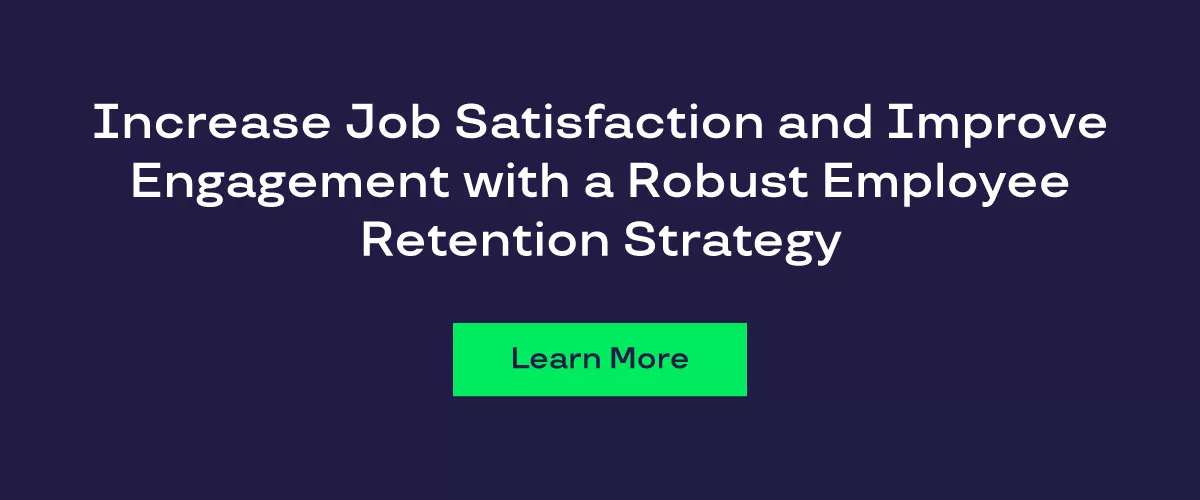
10 Benefits of Employee Retention
December 11, 2023
Retaining employees is imperative to business success, especially during an economic downturn. As organizations navigate a challenging economic climate, the benefits of retaining valuable employees become even more pronounced.
Why is employee retention so crucial for success? Quite simply, employees are the core of every business.
They are the driving force that ensures the seamless operation and progress of an organization, even in the face of adversity. Their experience and expertise are instrumental in helping businesses weather economic hardship, as they contribute to the development of innovative and creative strategies that propel the business forward.
In this article, we explore the top ten benefits of employee retention and explore strategies that businesses can use to retain their best talent.
What are the benefits of employee retention?
Employee retention offers a variety of benefits, both tangible and intangible. When employees stay, they bring with them institutional knowledge, skills, and experiences that are invaluable to the organization. This continuity ensures that projects remain on track and that the company's operations run smoothly.
Most importantly, employee retention has a direct impact on a company's financial health. The costs associated with hiring, training, and onboarding new employees can be substantial. By retaining employees, companies can avoid these unnecessary expenses and instead invest in the growth and development of their valuable employees.
What are the top 10 benefits of employee retention for businesses?
In the dynamic world of business, where the landscape rapidly changes and competition is fierce, the importance of retaining skilled employees cannot be understated.
Here are ten critical ways organizations benefit from retaining employees:
- Increased Productivity: Experienced employees are often more efficient and knowledgeable, allowing them to be far more productive and efficient.
- Higher Employee Morale: A low turnover rate boosts confidence and morale among staff. High employee retention creates a sense of trust and stability in the organization, reducing employee stress and driving better results.
- Enhanced Company Culture: A high retention rate signals a thriving, healthy organization. Such companies often have a strong company culture where employees feel a sense of purpose and belonging. This positive environment not only attracts top talent but also encourages longer tenure, leading to a virtuous cycle of attracting and retaining the best in the industry.
- Better Customer Service: Long-term employees understand customer needs and can provide superior service. As a result, customers receive a stable and high-quality experience, fostering customer loyalty and repeat business.
- Preservation of Knowledge: Retained employees hold valuable institutional knowledge. Their expertise and experience are invaluable as organizations adapt and evolve to compete in an ever-changing landscape.
- Competitive Advantage: Retaining top talent gives companies an edge over competitors. Organizations with more tenured employees are often more productive and knowledgeable, resulting in better business outcomes.
- Reduced Disruption: With fewer disruptions from employee departures, teams can work cohesively, leading to better project outcomes and improved operations.
- Strengthened Brand Reputation: Companies known for retaining employees can often be seen as desirable places to work. This is likely from maintaining a supportive and healthy workplace culture, which can help attract and retain top talent.
- Increased Profitability: By retaining skilled employees, organizations can mitigate unnecessary talent management costs and improve their bottom line.
- Cost Savings: Hiring and training new employees is expensive. From the recruitment process to onboarding and training, costs can add up quickly. In fact, Gallup found that replacing an employee can cost between one-half to two times the employee’s annual salary. Organizations can save a significant amount of money by retaining their employees.
Why Retaining Employees is Better Than Hiring Replacements
The debate between retaining employees versus hiring replacements is a pertinent one. While fresh talent can bring new perspectives and energy to an organization, the benefits of retaining seasoned employees can often outweigh the allure of new hires. Here's why:
- Reduced Costs: Hiring new employees is expensive. From advertising vacancies and conducting interviews to training and onboarding, the costs quickly add up. In contrast, retaining an existing employee eliminates these expenses, leading to significant cost savings.
- Institutional Knowledge: Long-standing employees possess invaluable institutional knowledge. They understand the company's history, culture, processes, and nuances that a new hire might take months – or even years - to grasp.
- Relationships and Networks: Existing employees have built relationships within the organization and with clients, suppliers, and other stakeholders. These relationships are crucial for smooth operations and can be disrupted when an employee departs.
- Productivity: New employees require time to acclimate to their roles, leading to a dip in productivity. In contrast, tenured employees that are familiar with their responsibilities and processes, can maintain - or even enhance - their productivity levels.
- Morale and Culture: High turnover rates can negatively impact the morale of remaining employees, leading to uncertainty and apprehension. A stable workforce, on the other hand, fosters a sense of community and continuity.
- Training and Development: Investments made in training and developing employees can be lost when an employee leaves. Retaining employees ensures that the company benefits from its investment.
Although hiring new talent is necessary for every organization, the advantages of retaining experienced and skilled employees are undeniable. Retaining valuable employees ensures continuity, stability, and growth.
Why is employee retention more important now?
Employee retention is not an easy task for any organization. Especially, for organizations trying to retain the younger generations (Generation Z and Millennials) who are known to be more likely to job hop.
A Bankrate’s 2023 job seeker survey found that over half of the workforce is likely to look for a new job in the next 12 months. The survey also reported that 55% of respondents said they felt underpaid compared to peers with the same qualifications or work experience.
As organizations enter 2024 and beyond, they will need to prioritize retaining employees and improving job satisfaction. Here's a few reasons why retention will be important:
#1 Changing Demographics
The changing demographics of the workforce, with Millennials and Generation Z at the forefront, have reshaped expectations. These generations prioritize purpose, personal growth, and a harmonious work-life balance, compelling companies to offer more than just attractive compensation packages.
#2 Shift to Flexible Workplace Models
The global shift towards remote work, accelerated by the COVID-19 pandemic, has further intensified retention challenges. Geographic boundaries no longer tether employees, broadening their employment options and making retention even more paramount for businesses.
#3 A Company's Brand Reputation
A company's reputation is closely linked to its retention rates. Organizations frequently experiencing turnover can face brand erosion, making them less appealing to potential customers and future talent alike.
#4 Advancements in Technology
The rapid pace of technological advancements further underscores the importance of retaining employees familiar with a company's specific systems and technologies, as onboarding new talent to these platforms can be both costly and time-consuming.
The importance of holding onto seasoned employees who can adeptly navigate challenges cannot be overstated. Retaining employees must be a top-priority for businesses aiming for long-term success – especially during an economic slowdown.
As organizations evolve to meet the needs of the modern workforce, employee retention will become a vital role in building a strong organizational foundation and driving business success.
What are the three most important factors for employee retention?
In today's diverse workforce, different generations prioritize different aspects of their jobs. Research conducted by Robert Half has shown that Generation Z, Millennials, Generation X, and Baby Boomers each have their own distinct needs and wants when it comes to their careers. For instance, Generation Z values work-life balance, while Generation X places a greater emphasis on competitive salary and regular merit increases.
But despite these differences, there are three key factors organizations can focus on to retain a multi-generational workforce:
- Job Satisfaction: At the heart of employee retention is job satisfaction. Employees need to feel that their roles are meaningful and that they're making a difference in the organization. This satisfaction comes from a combination of challenging work, recognition for achievements, and opportunities for growth and advancement. Companies that prioritize these aspects tend to have higher retention rates.
- Work-Life Balance: In today's fast-paced world, work-life balance has become a critical factor in employee retention. Employees value their time outside of work and seek employers who respect this balance. This can mean offering flexible work hours, remote work options, or additional vacation days. A company that supports its employees' well-being outside of work is more likely to retain them.
- Compensation and Benefits: While not the only factor, competitive compensation and benefits packages are undeniably crucial for retention. This includes not just salary, but also health benefits, retirement plans, and other perks. Regularly reviewing and adjusting compensation packages to align with industry standards can go a long way in retaining employees.
By prioritizing job satisfaction, work-life balance, and competitive compensation, companies can enhance the employee experience across a multi-generational workforce, resulting in higher employee retention rates.
What Improves Employee Retention?
Employee retention is a challenge for any organization. Unfortunately, there are no one-size fits all solutions for organizations looking to improve retention rates. This can lead many HR leaders wondering which strategies should be implemented.
While there isn’t a silver bullet HR leaders can use, there are still many targeted strategies organizations can adopt to improve retention rates and create a healthier culture.
But, before you start planning and implementing any retention initiatives, it’s crucial that you identify the underlying issues within your organization that are driving higher employee turnover. Consider implementing culture-based employee feedback surveys and an anonymous pulse survey first to see how your employees feel about your organization. With these key insights, you can then develop proper strategies to solve the identified issues and fix the root cause.
Here are some effective strategies you can implement to improve employee retention:
- Mentorship Programs: Pair new employees with seasoned professionals for guidance and coaching. By encouraging these relationships, you can help upskill workers and encourage strong connections between your employees.
- Meaningful Recognition: Celebrate your employees’ big achievement and work milestones with meaningful rewards and recognition. Employee recognition and engagement platforms are a great way to encourage a culture of recognition within a single location. You can use points-based recognition to foster peer-to-peer recognition.
- Continuous Learning Opportunities: Offer career courses, workshops, and seminars. Advocate for team leaders to put a portion of their budget towards skill building workshops and events, showing employees that the organization values their contributions.
- Employee Feedback: Gone are the days of the traditional once-a-year annual feedback survey. Implement an anonymous pulse survey to see how employees are feeling day-to-day to identify underlying issues that are leading to turnover.
- Wellness Programs: As we all know, healthy employees are happy and productive employees! To support your workforce’s health, implement initiatives focused on mental and physical well-being. A fun way you can do this is through monthly wellness challenges that encourage healthy habits.
- Diverse and Inclusive Environment: Promote a culture of respect and inclusivity. Use a top-down approach, holding your leadership accountable to adhering to diversity, equity, and inclusion (DEI) initiatives.
- Effective Employee Onboarding: Creating a strong, well thought-out onboarding process can have a significant impact on an employee’s tenure. In fact, employees are 69% more likely to stay with a company for three years if they have a structured orientation program.
- Flexible Work Schedule: An effective and easy strategy for retaining talent is offering a flexible work schedule. Not only can this help you retain employees, but it can draw in top talent.
- Commuting Subsidies: With many organizations implementing return to office mandates, a great way to help retain employees during the transition is implementing commuting subsidies to help offset the new costs from driving to work and to provide an extra perk for employees.
Adopting these targeted strategies can help organizations improve employee retention rates, promote engagement and satisfaction, and foster professional growth and development.
Bear in mind, though, for these initiatives to be successful, you must have leadership buy-in and keep open communication with the organization. Additionally, consider tracking employee sentiment to assess the effectiveness of your initiatives. Conduct regular check-ins and provide an anonymous pulse survey to gauge the impact of these strategies on employee satisfaction.
Conclusion
Employee retention is a big challenge for many organizations in today’s work environment. Unfortunately, retention can have negative implications on organizations, impacting their culture to for a company's success.
The benefits of retaining top talent are numerous, from cost savings and increased productivity to a strengthened brand reputation. By understanding the key factors that drive retention and implementing targeted strategies, companies can ensure they not only attract the best talent but also keep them for the long haul.





